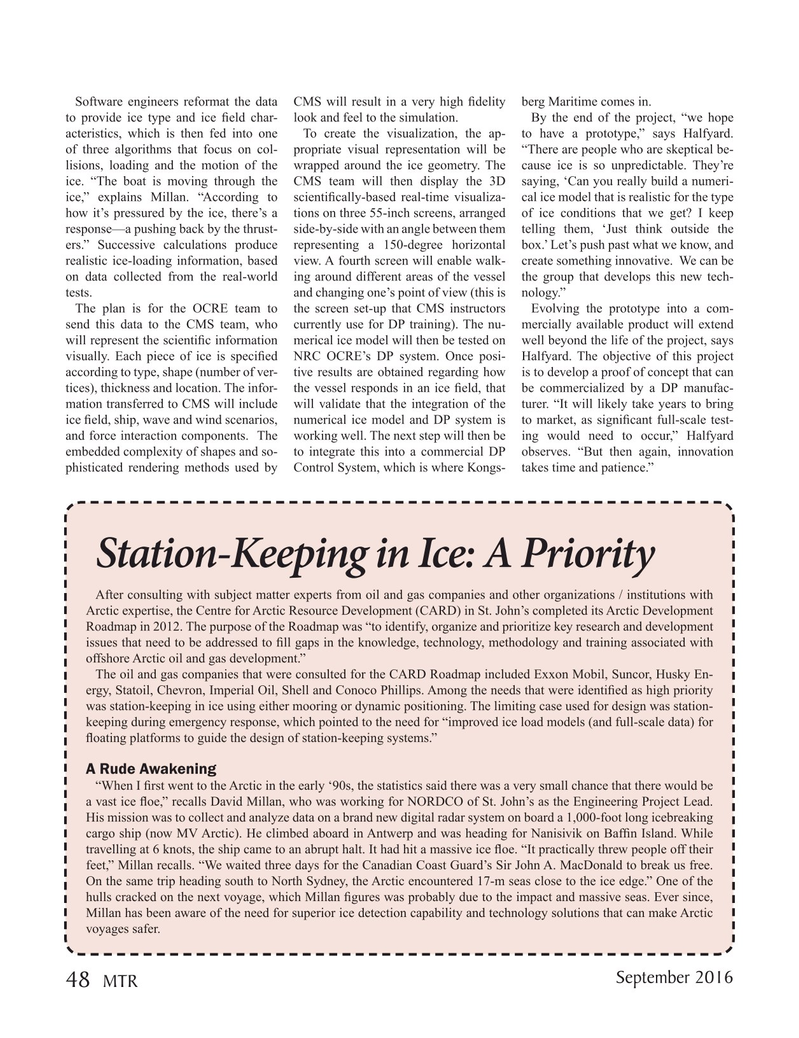
Page 48: of Marine Technology Magazine (September 2016)
Ocean Observation: Gliders, Buoys & Sub-Surface Networks
Read this page in Pdf, Flash or Html5 edition of September 2016 Marine Technology Magazine
Software engineers reformat the data CMS will result in a very high ? delity berg Maritime comes in.
to provide ice type and ice ? eld char- look and feel to the simulation. By the end of the project, “we hope acteristics, which is then fed into one To create the visualization, the ap- to have a prototype,” says Halfyard. of three algorithms that focus on col- propriate visual representation will be “There are people who are skeptical be- lisions, loading and the motion of the wrapped around the ice geometry. The cause ice is so unpredictable. They’re ice. “The boat is moving through the CMS team will then display the 3D saying, ‘Can you really build a numeri- ice,” explains Millan. “According to scienti? cally-based real-time visualiza- cal ice model that is realistic for the type how it’s pressured by the ice, there’s a tions on three 55-inch screens, arranged of ice conditions that we get? I keep response—a pushing back by the thrust- side-by-side with an angle between them telling them, ‘Just think outside the ers.” Successive calculations produce representing a 150-degree horizontal box.’ Let’s push past what we know, and realistic ice-loading information, based view. A fourth screen will enable walk- create something innovative. We can be on data collected from the real-world ing around different areas of the vessel the group that develops this new tech- tests. and changing one’s point of view (this is nology.”
The plan is for the OCRE team to the screen set-up that CMS instructors Evolving the prototype into a com- send this data to the CMS team, who currently use for DP training). The nu- mercially available product will extend will represent the scienti? c information merical ice model will then be tested on well beyond the life of the project, says visually. Each piece of ice is speci? ed NRC OCRE’s DP system. Once posi- Halfyard. The objective of this project according to type, shape (number of ver- tive results are obtained regarding how is to develop a proof of concept that can tices), thickness and location. The infor- the vessel responds in an ice ? eld, that be commercialized by a DP manufac- mation transferred to CMS will include will validate that the integration of the turer. “It will likely take years to bring ice ? eld, ship, wave and wind scenarios, numerical ice model and DP system is to market, as signi? cant full-scale test- and force interaction components. The working well. The next step will then be ing would need to occur,” Halfyard embedded complexity of shapes and so- to integrate this into a commercial DP observes. “But then again, innovation phisticated rendering methods used by Control System, which is where Kongs- takes time and patience.”
Station-Keeping in Ice: A Priority
After consulting with subject matter experts from oil and gas companies and other organizations / institutions with
Arctic expertise, the Centre for Arctic Resource Development (CARD) in St. John’s completed its Arctic Development
Roadmap in 2012. The purpose of the Roadmap was “to identify, organize and prioritize key research and development issues that need to be addressed to ? ll gaps in the knowledge, technology, methodology and training associated with offshore Arctic oil and gas development.”
The oil and gas companies that were consulted for the CARD Roadmap included Exxon Mobil, Suncor, Husky En- ergy, Statoil, Chevron, Imperial Oil, Shell and Conoco Phillips. Among the needs that were identi? ed as high priority was station-keeping in ice using either mooring or dynamic positioning. The limiting case used for design was station- keeping during emergency response, which pointed to the need for “improved ice load models (and full-scale data) for ? oating platforms to guide the design of station-keeping systems.”
A Rude Awakening “When I ? rst went to the Arctic in the early ‘90s, the statistics said there was a very small chance that there would be a vast ice ? oe,” recalls David Millan, who was working for NORDCO of St. John’s as the Engineering Project Lead.
His mission was to collect and analyze data on a brand new digital radar system on board a 1,000-foot long icebreaking cargo ship (now MV Arctic). He climbed aboard in Antwerp and was heading for Nanisivik on Baf? n Island. While travelling at 6 knots, the ship came to an abrupt halt. It had hit a massive ice ? oe. “It practically threw people off their feet,” Millan recalls. “We waited three days for the Canadian Coast Guard’s Sir John A. MacDonald to break us free.
On the same trip heading south to North Sydney, the Arctic encountered 17-m seas close to the ice edge.” One of the hulls cracked on the next voyage, which Millan ? gures was probably due to the impact and massive seas. Ever since,
Millan has been aware of the need for superior ice detection capability and technology solutions that can make Arctic voyages safer.
September 2016 48
MTR
MTR #7 (34-49).indd 48 8/24/2016 1:49:29 PM

 47
47

 49
49
